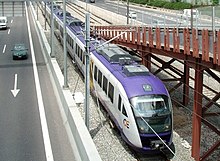Hellenic Shipyards
| Hellenic Shipyards | |
|---|---|
| legal form | Anonymous Etaireia |
| founding | 1957 |
| Seat | Chaidari , Greece |
| management | Christodoulos Seferis (Special Administrator) |
| Branch | mechanical engineering |
| Website | hsy-under-special-administration.gr |
Hellenic Shipyards ( Greek Ελληνικά Ναυπηγεία Σκαραμαγκά ) is a shipyard in Skaramagas near Athens in Greece . In the largest shipyard in the eastern Mediterranean , in addition to ships and submarines , railcars are also manufactured in cooperation with Bombardier Transportation and Siemens .
history

At the site of today's shipyard there was a small shipyard from 1939 that manufactured warships for the Greek Navy . In 1952 the shipowner tycoon Stavros Niarchos acquired the site and founded the Hellenic Shipyards. Over 9,000 ships were repaired or built, 170 of them for the United States Navy . From the 1980s, the production of rail vehicles began. In 2002 the German HDW Group acquired the company, which was eventually taken over by ThyssenKrupp .
Hellenic Shipyards is also active in the manufacture of rail vehicles, initially for the Athens subway , then the OSE series 460 , which was developed by Siemens Mobility and is based on the Desiro concept.
In January 2008, the company received an order from Hochtief for the first time to manufacture a drilling platform. In March 2010 it was announced that Abu Dhabi MAR had acquired 75% of the shares in Hellenic Shipyards from ThyssenKrupp Marine Systems (TKMS); 24.9% stayed with ThyssenKrupp.
In the years 1996 to 2002, Hellenic Shipyards had repeatedly received subsidies from the Greek government and the state bank ETVA due to considerable financial difficulties . The European Commission found in 2008 that this aid was illegal. A legal dispute arose because the Greek government initially refused to accept repayment of the aid, as Hellenic Shipyards was one of the most important producers of military equipment for the Greek Navy and the government saw its national security interests at risk. In 2010, the Commission accepted a compromise proposal that waived full repayment of aid in exchange for a sale of the civilian operations of the company and a 15-year ban on all non-military activities. However, the sale of the private sector did not take place until 2018, when the Greek government appointed a special administrator for the shipyard in March of that year. He was given the task of completely separating and selling the private and military parts of the company. For the military sector, only interested parties from other NATO member states were considered. At that time, Hellenic Shipyards owed its creditors a total of approximately € 6.67 billion.
capacity
The shipyard is the largest shipyard in Greece and one of the largest in the Mediterranean. 18 ships can be edited at the same time.
Web links
- Hellenic Shipyards website (English, Greek)
Individual evidence
- ↑ Under Company Profile on archive link ( Memento of the original from May 9, 2005 in the Internet Archive ) Info: The archive link was automatically inserted and not yet checked. Please check the original and archive link according to the instructions and then remove this notice.
- ↑ Mark Latham: Aid to Greek shipyard ruled illegal. In: politico.eu. July 2, 2008, accessed January 23, 2020 .
- ↑ State aid: Commission accepts commitments from Greece regarding incompatible aid in favor of Hellenic Shipyards. In: ec.europa.eu/. European Commission, December 1, 2010, accessed January 23, 2020 .
- ↑ A. Tsimplakis: Athens court approves appointment of special administrator for Hellenic Shipyards; EU case on March 15. In: naftemporiki.gr. March 8, 2018, accessed January 23, 2020 .
Coordinates: 38 ° 0 '21.3 " N , 23 ° 35' 48.8" E